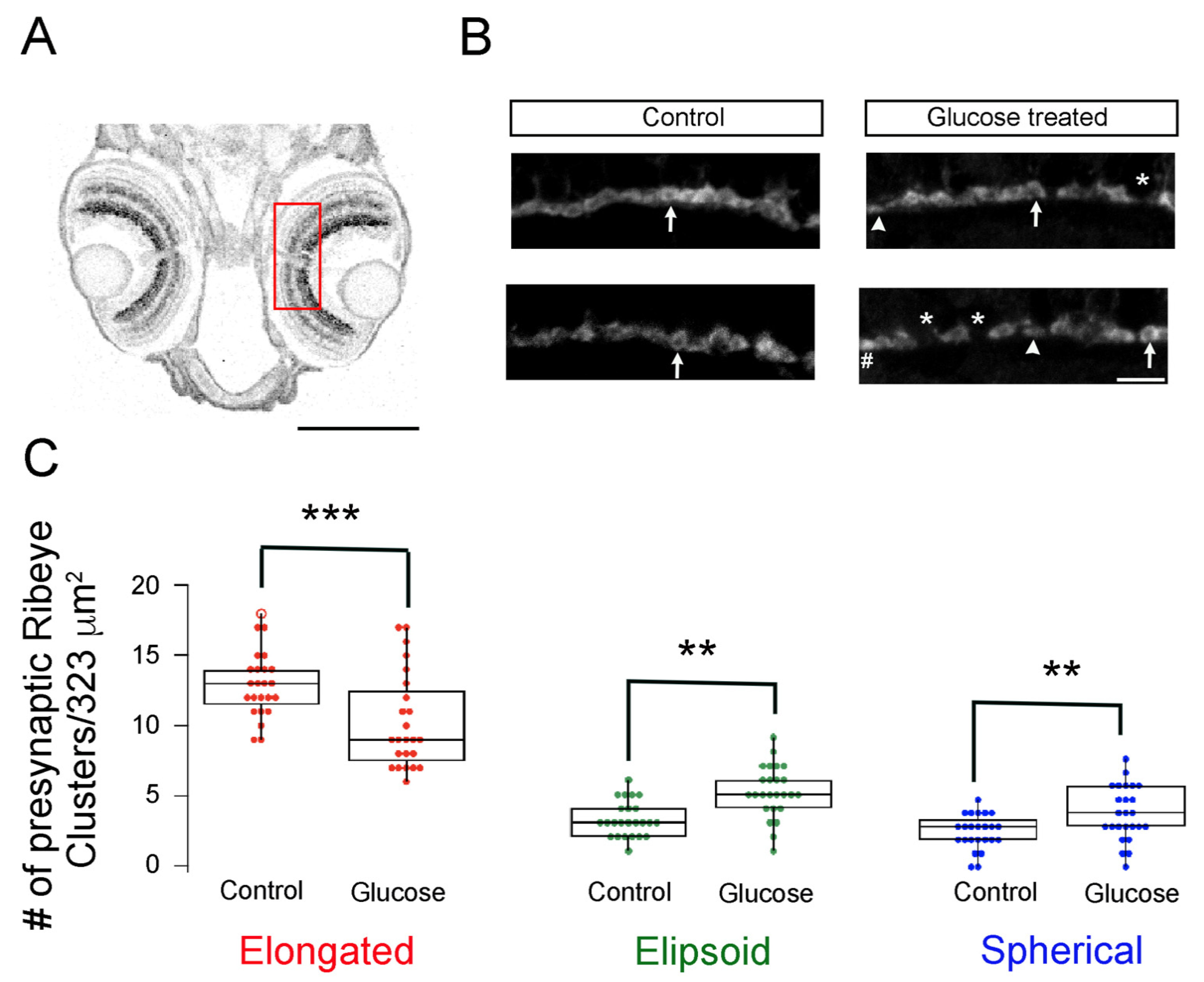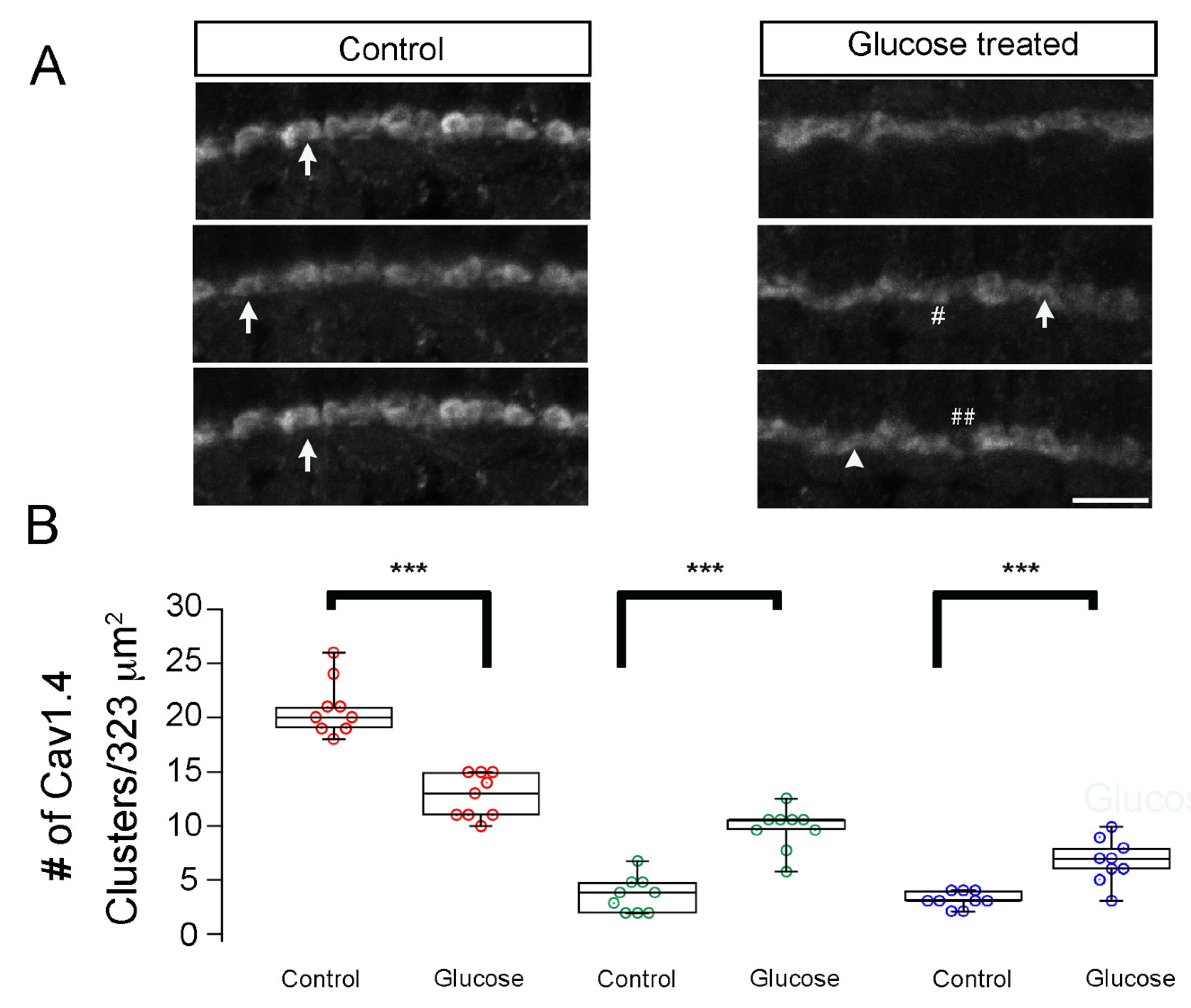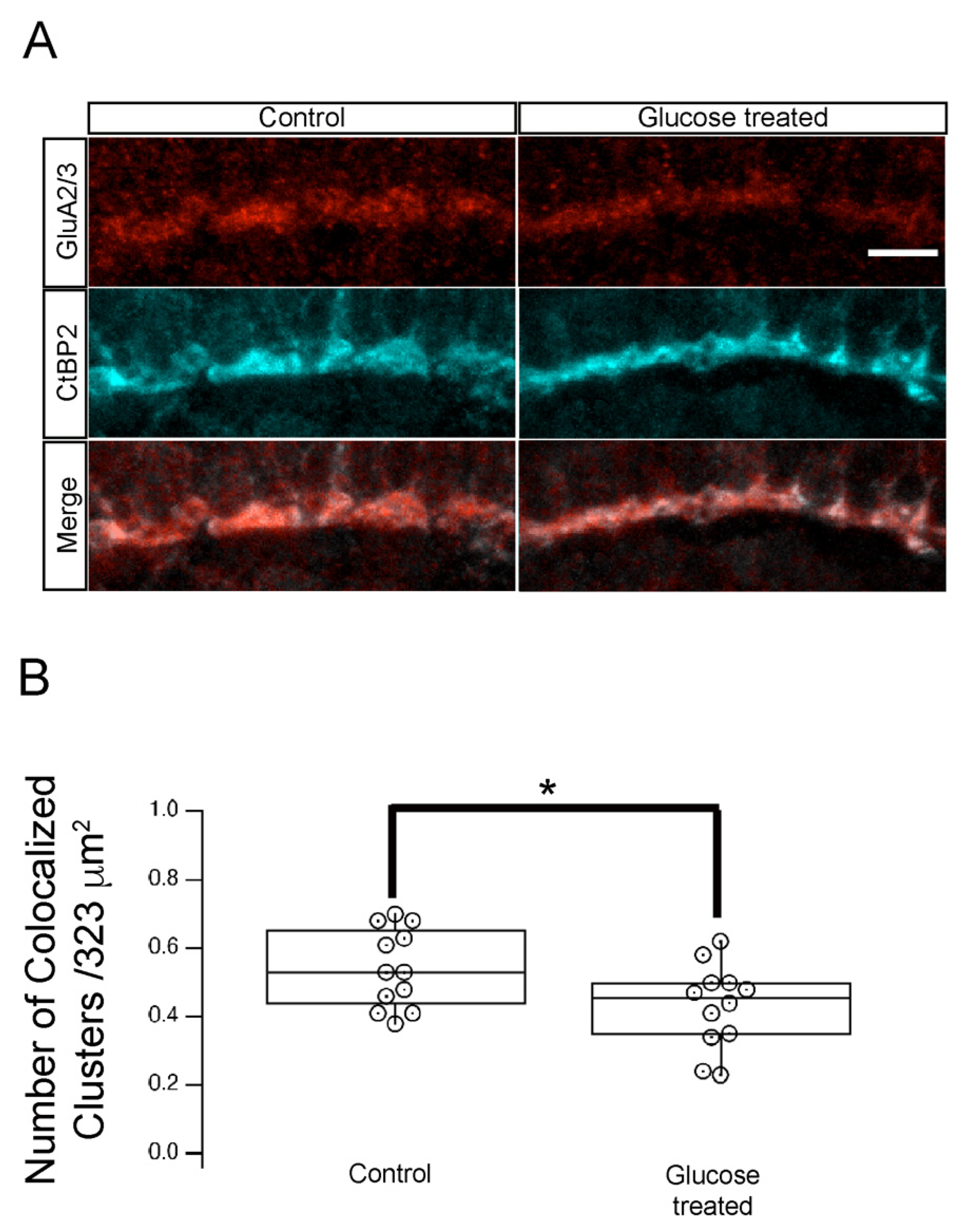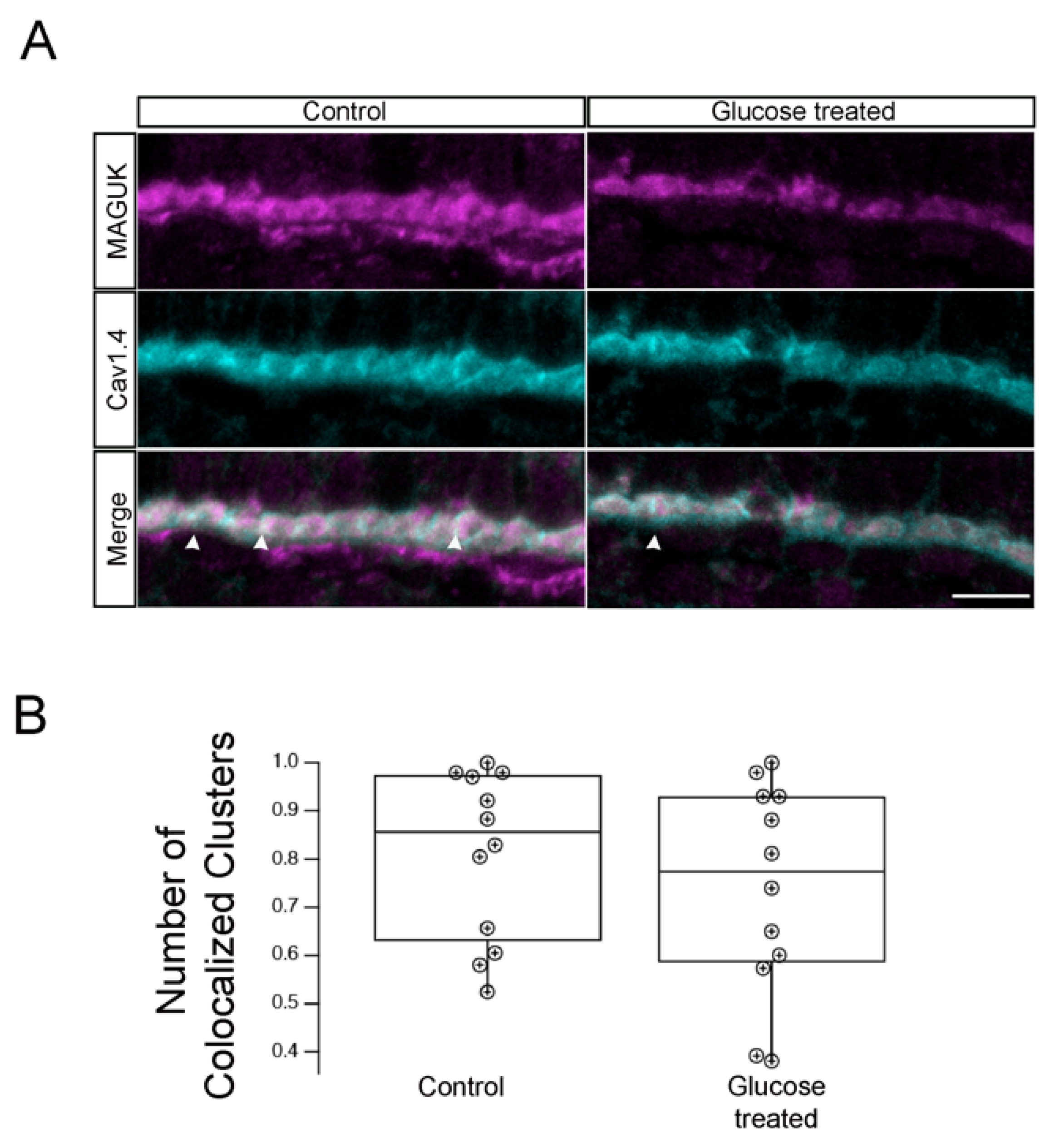Embryonic Hyperglycemia Delays the Development of Retinal Synapses in a Zebrafish Model
Abstract
:1. Introduction
2. Results
3. Discussion
4. Materials and Methods
4.1. Zebrafish Maintenance and Induction of Hyperglycemia
4.2. Immunofluorescence of the Retina
4.3. Data Acquisition and Image Analysis
4.4. Analysis of Synaptic Proteins by IHC
4.5. Analysis of Ribbon Synapses
4.6. Cell Counting
4.7. Glucose Measurement
4.8. Whole-Mount In Situ Hybridization (WISH)
4.9. Quantitative RT-PCR (RT-qPCR)
4.10. Statistical Analysis
Author Contributions
Funding
Institutional Review Board Statement
Informed Consent Statement
Data Availability Statement
Acknowledgments
Conflicts of Interest
References
- Tang, J.; Kern, T.S. Inflammation in diabetic retinopathy. Prog. Retin. Eye Res. 2011, 30, 343–358. [Google Scholar] [CrossRef] [PubMed]
- El-Remessy, A.B.; Al-Shabrawey, M.; Khalifa, Y.; Tsai, N.T.; Caldwell, R.B.; Liou, G.I. Neuroprotective and blood-retinal barrier-preserving effects of cannabidiol in experimental diabetes. Am. J. Pathol. 2006, 168, 235–244. [Google Scholar] [CrossRef] [PubMed]
- Xie, Z.; Wei, M.; Morgan, T.E.; Fabrizio, P.; Han, D.; Finch, C.E.; Longo, V.D. Peroxynitrite mediates neurotoxicity of amyloid beta-peptide1-42- and lipopolysaccharide-activated microglia. J. Neurosci. 2002, 22, 3484–3492. [Google Scholar] [CrossRef] [PubMed]
- Tariq, Y.M.; Samarawickrama, C.; Li, H.; Huynh, S.C.; Burlutsky, G.; Mitchell, P. Retinal thickness in the offspring of diabetic pregnancies. Am. J. Ophthalmol. 2010, 150, 883–887. [Google Scholar] [CrossRef]
- Chhetri, J.; Jacobson, G.; Gueven, N. Zebrafish—On the move towards ophthalmological research. Eye 2014, 28, 367–380. [Google Scholar] [CrossRef]
- Howe, K.; Clark, M.D.; Torroja, C.F.; Torrance, J.; Berthelot, C.; Muffato, M.; Collins, J.E.; Humphray, S.; McLaren, K.; Matthews, L. The zebrafish reference genome sequence and its relationship to the human genome. Nature 2013, 496, 498–503. [Google Scholar] [CrossRef]
- Singh, A.; Castillo, H.A.; Brown, J.; Kaslin, J.; Dwyer, K.M.; Gibert, Y. High glucose levels affect retinal patterning during zebrafish embryogenesis. Sci. Rep. 2019, 9, 4121. [Google Scholar] [CrossRef]
- Titialii-Torres, K.F.; Morris, A.C. Embryonic hyperglycemia perturbs the development of specific retinal cell types, including photoreceptors. J. Cell Sci. 2022, 135, jcs259187. [Google Scholar] [CrossRef]
- Larison, K.D.; Bremiller, R. Early onset of phenotype and cell patterning in the embryonic zebrafish retina. Development 1990, 109, 567–576. [Google Scholar] [CrossRef]
- Fadool, J.M. Development of a rod photoreceptor mosaic revealed in transgenic zebrafish. Dev. Biol. 2003, 258, 277–290. [Google Scholar] [CrossRef] [Green Version]
- Matthews, G.; Fuchs, P. The diverse roles of ribbon synapses in sensory neurotransmission. Nat. Rev. Neurosci. 2010, 11, 812–822. [Google Scholar] [CrossRef] [PubMed]
- Moser, T.; Grabner, C.; Schmitz, F. Sensory Processing at Ribbon Synapses in the Retina and the Cochlea. Physiol. Rev. 2020, 100, 103–144. [Google Scholar] [CrossRef] [PubMed]
- Schmitz, F. The making of synaptic ribbons: How they are built and what they do. Neuroscientist 2009, 15, 611–624. [Google Scholar] [CrossRef] [PubMed]
- Wan, L.; Almers, W.; Chen, W. Two ribeye genes in teleosts: The role of Ribeye in ribbon formation and bipolar cell development. J. Neurosci. 2005, 25, 941–949. [Google Scholar] [CrossRef]
- Biehlmaier, O.; Neuhauss, S.C.; Kohler, K. Synaptic plasticity and functionality at the cone terminal of the developing zebrafish retina. J. Neurobiol. 2003, 56, 222–236. [Google Scholar] [CrossRef]
- Hermes, B.; Reuss, S.; Vollrath, L. Synaptic ribbons, spheres and intermediate structures in the developing rat retina. Int. J. Dev. Neurosci. 1992, 10, 215–223. [Google Scholar] [CrossRef]
- Allwardt, B.A.; Lall, A.B.; Brockerhoff, S.E.; Dowling, J.E. Synapse formation is arrested in retinal photoreceptors of the zebrafish nrc mutant. J. Neurosci. 2001, 21, 2330–2342. [Google Scholar] [CrossRef]
- Schmitz, F.; Königstorfer, A.; Südhof, T.C. RIBEYE, a component of synaptic ribbons: A protein’s journey through evolution provides insight into synaptic ribbon function. Neuron 2000, 28, 857–872. [Google Scholar] [CrossRef]
- Holzhausen, L.C.; Lewis, A.A.; Cheong, K.K.; Brockerhoff, S.E. Differential role for synaptojanin 1 in rod and cone photoreceptors. J. Comp. Neurol. 2009, 517, 633–644. [Google Scholar] [CrossRef]
- Trapani, J.G.; Obholzer, N.; Mo, W.; Brockerhoff, S.E.; Nicolson, T. Synaptojanin1 is required for temporal fidelity of synaptic transmission in hair cells. PLoS Genet. 2009, 5, e1000480. [Google Scholar] [CrossRef] [Green Version]
- Van Epps, H.A.; Hayashi, M.; Lucast, L.; Stearns, G.W.; Hurley, J.B.; De Camilli, P.; Brockerhoff, S.E. The zebrafish nrc mutant reveals a role for the polyphosphoinositide phosphatase synaptojanin 1 in cone photoreceptor ribbon anchoring. J. Neurosci. 2004, 24, 8641–8650. [Google Scholar] [CrossRef] [PubMed]
- Dick, O.; tom Dieck, S.; Altrock, W.D.; Ammermüller, J.; Weiler, R.; Garner, C.C.; Gundelfinger, E.D.; Brandstätter, J.H. The presynaptic active zone protein bassoon is essential for photoreceptor ribbon synapse formation in the retina. Neuron 2003, 37, 775–786. [Google Scholar] [CrossRef]
- Hombrebueno, J.R.; Chen, M.; Penalva, R.G.; Xu, H. Loss of synaptic connectivity, particularly in second order neurons is a key feature of diabetic retinal neuropathy in the Ins2Akita mouse. PLoS ONE 2014, 9, e97970. [Google Scholar] [CrossRef] [PubMed]
- Graffe, M.; Zenisek, D.; Taraska, J.W. A marginal band of microtubules transports and organizes mitochondria in retinal bipolar synaptic terminals. J. Gen. Physiol. 2015, 146, 109–117. [Google Scholar] [CrossRef] [PubMed]
- Hoshi, H.; Sato, F. The morphological characterization of orientation-biased displaced large-field ganglion cells in the central part of goldfish retina. J. Comp. Neurol. 2018, 526, 243–261. [Google Scholar] [CrossRef]
- Liu, X.; Kerov, V.; Haeseleer, F.; Majumder, A.; Artemyev, N.; Baker, S.A.; Lee, A. Dysregulation of Ca(v)1.4 channels disrupts the maturation of photoreceptor synaptic ribbons in congenital stationary night blindness type 2. Channels 2013, 7, 514–523. [Google Scholar] [CrossRef]
- Jia, S.; Muto, A.; Orisme, W.; Henson, H.E.; Parupalli, C.; Ju, B.; Baier, H.; Taylor, M.R. Zebrafish Cacna1fa is required for cone photoreceptor function and synaptic ribbon formation. Hum. Mol. Genet. 2014, 23, 2981–2994. [Google Scholar] [CrossRef]
- Ryl, M.; Urbasik, A.; Gierke, K.; Babai, N.; Joachimsthaler, A.; Feigenspan, A.; Frischknecht, R.; Stallwitz, N.; Fejtová, A.; Kremers, J.; et al. Genetic disruption of bassoon in two mutant mouse lines causes divergent retinal phenotypes. FASEB J. 2021, 35, e21520. [Google Scholar] [CrossRef]
- Dembla, E.; Dembla, M.; Maxeiner, S.; Schmitz, F. Synaptic ribbons foster active zone stability and illumination-dependent active zone enrichment of RIM2 and Cav1.4 in photoreceptor synapses. Sci. Rep. 2020, 10, 5957. [Google Scholar] [CrossRef]
- Hack, I.; Frech, M.; Dick, O.; Peichl, L.; Brandstätter, J.H. Heterogeneous distribution of AMPA glutamate receptor subunits at the photoreceptor synapses of rodent retina. Eur. J. Neurosci. 2001, 13, 15–24. [Google Scholar]
- Meyer, M.P.; Trimmer, J.S.; Gilthorpe, J.D.; Smith, S.J. Characterization of zebrafish PSD-95 gene family members. J. Neurobiol. 2005, 63, 91–105. [Google Scholar] [CrossRef] [PubMed]
- Boeckers, T.M. The postsynaptic density. Cell Tissue Res. 2006, 326, 409–422. [Google Scholar] [CrossRef]
- Heidelberger, R.; Matthews, G. Calcium influx and calcium current in single synaptic terminals of goldfish retinal bipolar neurons. J. Physiol. 1992, 447, 235–256. [Google Scholar] [CrossRef] [PubMed]
- Schmitt, E.A.; Dowling, J.E. Early retinal development in the zebrafish, Danio rerio: Light and electron microscopic analyses. J. Comp. Neurol. 1999, 404, 515–536. [Google Scholar] [CrossRef]
- Takamori, S.; Holt, M.; Stenius, K.; Lemke, E.A.; Grønborg, M.; Riedel, D.; Urlaub, H.; Schenck, S.; Brügger, B.; Ringler, P.; et al. Molecular anatomy of a trafficking organelle. Cell 2006, 127, 831–846. [Google Scholar] [CrossRef]
- Dhingra, N.K.; Ramamohan, Y.; Raju, T.R. Developmental expression of synaptophysin, synapsin I and syntaxin in the rat retina. Dev. Brain Res. 1997, 102, 267–273. [Google Scholar] [CrossRef]
- Brandstätter, J.H.; Löhrke, S.; Morgans, C.W.; Wässle, H. Distributions of two homologous synaptic vesicle proteins, synaptoporin and synaptophysin, in the mammalian retina. J. Comp. Neurol. 1996, 370, 1–10. [Google Scholar] [CrossRef]
- Wiedenmann, B.; Franke, W.W. Identification and localization of synaptophysin, an integral membrane glycoprotein of Mr 38,000 characteristic of presynaptic vesicles. Cell 1985, 41, 1017–1028. [Google Scholar] [CrossRef]
- Khvotchev, M.V.; Südhof, T.C. Stimulus-dependent dynamic homo- and heteromultimerization of synaptobrevin/VAMP and synaptophysin. Biochemistry 2004, 43, 15037–15043. [Google Scholar] [CrossRef]
- Cameron, P.L.; Südhof, T.C.; Jahn, R.; De Camilli, P. Colocalization of synaptophysin with transferrin receptors: Implications for synaptic vesicle biogenesis. J. Cell Biol. 1991, 115, 151–164. [Google Scholar] [CrossRef]
- Eshkind, L.G.; Leube, R.E. Mice lacking synaptophysin reproduce and form typical synaptic vesicles. Cell Tissue Res. 1995, 282, 423–433. [Google Scholar] [CrossRef] [PubMed]
- Leube, R.E.; Wiedenmann, B.; Franke, W.W. Topogenesis and sorting of synaptophysin: Synthesis of a synaptic vesicle protein from a gene transfected into nonneuroendocrine cells. Cell 1989, 59, 433–446. [Google Scholar] [CrossRef]
- Tarsa, L.; Goda, Y. Synaptophysin regulates activity-dependent synapse formation in cultured hippocampal neurons. Proc. Natl. Acad. Sci. USA 2002, 99, 1012–1016. [Google Scholar] [CrossRef] [PubMed]
- Thiele, C.; Hannah, M.J.; Fahrenholz, F.; Huttner, W.B. Cholesterol binds to synaptophysin and is required for biogenesis of synaptic vesicles. Nat. Cell Biol. 2000, 2, 42–49. [Google Scholar] [CrossRef] [PubMed]
- Thomas, L.; Hartung, K.; Langosch, D.; Rehm, H.; Bamberg, E.; Franke, W.W.; Betz, H. Identification of synaptophysin as a hexameric channel protein of the synaptic vesicle membrane. Science 1988, 242, 1050–1053. [Google Scholar] [CrossRef] [PubMed]
- Shrestha, A.; Vaithianathan, T. Tracking the dynamics of single fused synaptic vesicle proteins from a single ribbon active zone in zebrafish retinal bipolar cells. STAR Protoc. 2022, 3, 101107. [Google Scholar] [CrossRef]
- Vaithianathan, T.; Henry, D.; Akmentin, W.; Matthews, G. Nanoscale dynamics of synaptic vesicle trafficking and fusion at the presynaptic active zone. Elife 2016, 5, e13245. [Google Scholar] [CrossRef]
- Bennett, M.K.; Calakos, N.; Scheller, R.H. Syntaxin: A synaptic protein implicated in docking of synaptic vesicles at presynaptic active zones. Science 1992, 257, 255–259. [Google Scholar] [CrossRef]
- Greengard, P.; Valtorta, F.; Czernik, A.J.; Benfenati, F. Synaptic vesicle phosphoproteins and regulation of synaptic function. Science 1993, 259, 780–785. [Google Scholar] [CrossRef]
- Ripoli, C.; Spinelli, M.; Natale, F.; Fusco, S.; Grassi, C. Glucose Overload Inhibits Glutamatergic Synaptic Transmission: A Novel Role for CREB-Mediated Regulation of Synaptotagmins 2 and 4. Front. Cell Dev. Biol. 2020, 8, 810. [Google Scholar] [CrossRef]
- Malicki, J.; Neuhauss, S.C.; Schier, A.F.; Solnica-Krezel, L.; Stemple, D.L.; Stainier, D.Y.; Abdelilah, S.; Zwartkruis, F.; Rangini, Z.; Driever, W. Mutations affecting development of the zebrafish retina. Development 1996, 123, 263–273. [Google Scholar] [CrossRef] [PubMed]
- Maxeiner, S.; Luo, F.; Tan, A.; Schmitz, F.; Südhof, T.C. How to make a synaptic ribbon: RIBEYE deletion abolishes ribbons in retinal synapses and disrupts neurotransmitter release. EMBO J. 2016, 35, 1098–1114. [Google Scholar] [CrossRef] [PubMed]
- Sheets, L.; Trapani, J.G.; Mo, W.; Obholzer, N.; Nicolson, T. Ribeye is required for presynaptic CaV1.3a channel localization and afferent innervation of sensory hair cells. Development 2011, 138, 1309–1319. [Google Scholar] [CrossRef] [PubMed]
- Lv, C.; Stewart, W.J.; Akanyeti, O.; Frederick, C.; Zhu, J.; Santos-Sacchi, J.; Sheets, L.; Liao, J.C.; Zenisek, D. Synaptic Ribbons Require Ribeye for Electron Density, Proper Synaptic Localization, and Recruitment of Calcium Channels. Cell Rep. 2016, 15, 2784–2795. [Google Scholar] [CrossRef] [PubMed]
- Mukherjee, A.; Morales-Scheihing, D.; Butler, P.C.; Soto, C. Type 2 diabetes as a protein misfolding disease. Trends Mol. Med. 2015, 21, 439–449. [Google Scholar] [CrossRef] [PubMed]
- Sonntag, S.; Dedek, K.; Dorgau, B.; Schultz, K.; Schmidt, K.F.; Cimiotti, K.; Weiler, R.; Löwel, S.; Willecke, K.; Janssen-Bienhold, U. Ablation of retinal horizontal cells from adult mice leads to rod degeneration and remodeling in the outer retina. J. Neurosci. 2012, 32, 10713–10724. [Google Scholar] [CrossRef]
- Haverkamp, S.; Wässle, H. Immunocytochemical analysis of the mouse retina. J. Comp. Neurol. 2000, 424, 1–23. [Google Scholar] [CrossRef]
- Zanazzi, G.; Matthews, G. Enrichment and differential targeting of complexins 3 and 4 in ribbon-containing sensory neurons during zebrafish development. Neural Dev. 2010, 5, 24. [Google Scholar] [CrossRef]
- Wei, X.; Luo, Y.; Hyde, D.R. Molecular cloning of three zebrafish lin7 genes and their expression patterns in the retina. Exp. Eye Res. 2006, 82, 122–131. [Google Scholar] [CrossRef]
- Sheets, L.; Hagen, M.W.; Nicolson, T. Characterization of Ribeye subunits in zebrafish hair cells reveals that exogenous Ribeye B-domain and CtBP1 localize to the basal ends of synaptic ribbons. PLoS ONE 2014, 9, e107256. [Google Scholar]
- Schmitt, U.; Tanimoto, N.; Seeliger, M.; Schaeffel, F.; Leube, R.E. Detection of behavioral alterations and learning deficits in mice lacking synaptophysin. Neuroscience 2009, 162, 234–243. [Google Scholar] [CrossRef]
- Sebe, J.Y.; Cho, S.; Sheets, L.; Rutherford, M.A.; von Gersdorff, H.; Raible, D.W. Ca2+-Permeable AMPARs Mediate Glutamatergic Transmission and Excitotoxic Damage at the Hair Cell Ribbon Synapse. J. Neurosci. 2017, 37, 6162. [Google Scholar] [CrossRef] [PubMed] [Green Version]
- Medalla, M.; Luebke, J.I. Diversity of Glutamatergic Synaptic Strength in Lateral Prefrontal versus Primary Visual Cortices in the Rhesus Monkey. J. Neurosci. 2015, 35, 112. [Google Scholar] [CrossRef] [PubMed]
- Fogarty, M.J.; Hammond, L.A.; Kanjhan, R.; Bellingham, M.C.; Noakes, P.G. A method for the three-dimensional reconstruction of Neurobiotin-filled neurons and the location of their synaptic inputs. Front. Neural Circuits 2013, 7, 153. [Google Scholar] [CrossRef]
- Testen, A.; Kim, R.; Reissner, K.J. High-Resolution Three-Dimensional Imaging of Individual Astrocytes Using Confocal Microscopy. Curr. Protoc. Neurosci. 2020, 91, e92. [Google Scholar] [CrossRef] [PubMed]
- Fraher, D.; Ellis, M.K.; Morrison, S.; McGee, S.L.; Ward, A.C.; Walder, K.; Gibert, Y. Lipid Abundance in Zebrafish Embryos Is Regulated by Complementary Actions of the Endocannabinoid System and Retinoic Acid Pathway. Endocrinology 2015, 156, 3596–3609. [Google Scholar] [CrossRef] [Green Version]







| Antigen | Antiserum | Host | Dilution | Source (Number) | Marker for | Reference |
|---|---|---|---|---|---|---|
| PKC | Monoclonal anti-PKC | Mouse | 1:250 | Santa Cruz (sc-17769) | Rod-type bipolar cells | [59] |
| Ribeye | Polyclonal anti-ribeye | Rabbit | 1:1000 | Zenisek lab (s4561-2) | Synaptic ribbons (IPL) | [60] |
| CtBP | Monoclonal anti-CtBP (b-3) | Mouse | 1:100 | Santa Cruz (sc-55502) | Synaptic ribbons (OPL and IPL) | [24] |
| Cav1.4 | Polyclonal anti-Ca2+ channel L-type alpha-1F | Rabbit | 1:500 | Synaptic Systems (365-003) | OPL photoreceptor terminals | [28] |
| Synaptophysin | Polyclonal anti-synaptophysin | Rabbit | 1:250 | Alomone lab (ANR-013) | Synaptic vesicles | [61] |
| Pan-MAGUK | Monoclonal pan-MAGUK, clone K28/86 | Mouse | 1:250 | Millipore Sigma (MABN72MI) | Postsynaptic excitatory glutamatergic synapses | [62] |
| GluR2/3 | Polyclonal anti-GluR2/3 | Rabbit | 1:250 | Millipore Sigma (07-598) | OFF bipolar and horizontal cell dendrites | [63] |
| Forward Primer | Reverse Primer | |
|---|---|---|
| Ribeye a | CTATACCGTACCAATGGAGCTAATG | GCATCTCCACAGTACAGTCTCTC |
| Ribeye b | CAGAGCGGCTCCGAAGACGTTTTCCGGC | ACAGAAGGCAACGGTTGCCAGATC |
| Gria2a/GluR2a | GAGCAGGGGCTTCTGGATAAAT | TCTGTGAACGTCATCCCACTA |
| Cav1.3a | ACAGGAACCAGTACCTGCAGA | CCATTTCGTCAATGGTCATCT |
| Cav1.4a | CCCCTAGAAGCACGCCTATG | CCACTTGCTGGGTAAGGGAG |
| 18S rRNA | TCGCTAGTTGGCATCGTTTATG | CGGAGGTTCGAAGACGATCA |
Publisher’s Note: MDPI stays neutral with regard to jurisdictional claims in published maps and institutional affiliations. |
© 2022 by the authors. Licensee MDPI, Basel, Switzerland. This article is an open access article distributed under the terms and conditions of the Creative Commons Attribution (CC BY) license (https://creativecommons.org/licenses/by/4.0/).
Share and Cite
Shrestha, A.P.; Saravanakumar, A.; Konadu, B.; Madireddy, S.; Gibert, Y.; Vaithianathan, T. Embryonic Hyperglycemia Delays the Development of Retinal Synapses in a Zebrafish Model. Int. J. Mol. Sci. 2022, 23, 9693. https://doi.org/10.3390/ijms23179693
Shrestha AP, Saravanakumar A, Konadu B, Madireddy S, Gibert Y, Vaithianathan T. Embryonic Hyperglycemia Delays the Development of Retinal Synapses in a Zebrafish Model. International Journal of Molecular Sciences. 2022; 23(17):9693. https://doi.org/10.3390/ijms23179693
Chicago/Turabian StyleShrestha, Abhishek P., Ambalavanan Saravanakumar, Bridget Konadu, Saivikram Madireddy, Yann Gibert, and Thirumalini Vaithianathan. 2022. "Embryonic Hyperglycemia Delays the Development of Retinal Synapses in a Zebrafish Model" International Journal of Molecular Sciences 23, no. 17: 9693. https://doi.org/10.3390/ijms23179693
APA StyleShrestha, A. P., Saravanakumar, A., Konadu, B., Madireddy, S., Gibert, Y., & Vaithianathan, T. (2022). Embryonic Hyperglycemia Delays the Development of Retinal Synapses in a Zebrafish Model. International Journal of Molecular Sciences, 23(17), 9693. https://doi.org/10.3390/ijms23179693






